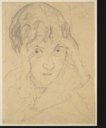About the Work
The 'Portrait of Fridel Battenberg', created in the war summer of 1916, is one of Max Beckmann's most haunting and personal portrait drawings. The way he portrays Fridel tells of the artist's intensive dialogue with his counterpart in an unusual way. Like a mirror image, it records the external appearance at close quarters and also demands moments of self-reflective stillness and mutual identification.
The wide-open eyes engage the artist's concentration. He subordinates all descriptive elements to the intensity of the gaze: the volume of the coiffed hair, the prominent nose, the narrow lips and the closed mouth are complemented by an understated decorative necklace, which marks the neck, and the roughly sketched upper body, which gradually fades out. Her slender arms are propped up, enabling the distinctively portrayed hands to hold her head in position while also limiting her field of vision. In contrast to the presence of the expressive face, the other lines and hatchings look restless and agitated, as if the artist did not want to interrupt the visual contact with his model during the drawing process.
The attempt at empathy that Beckmann articulates here presupposes an emotional link between himself and the person familiar to him. The extent to which the artist wished to make tangible in this pencil drawing his attention to the inner values of an individual together with an intimacy born of respect is emphasised when one compares it with the very different drawing by Ernst Ludwig Kirchner.
Fridel Battenberg (1880-1965) was the wife of the artist Ugi Battenberg (1879-1957), Beckmann's friend from their student days in Weimar. In 1915, the Battenbergs, who lived in Frankfurt, took Beckmann in after he suffered a breakdown as a volunteer medical auxiliary during the First World War. Beckmann had already achieved fame as an artist by then. He lived with the Battenbergs at Schweizer Straße 3 until 1919 and his friend's attic studio, which had been made available to him, remained his workplace until 1932. Many of Beckmann's sketches, drawings, prints and even paintings, such as the Städel's 'Synagogue' (1919), recall his close attachment during the early Frankfurt years. Almost all of Beckmann's works at the Städelsches Kunstinstitut were confiscated as 'degenerate' in 1937, but it was later possible to gradually acquire an outstanding group of prints and drawings from the Battenberg Collection, including this portrait dedicated to the pet cat 'Titti'.
